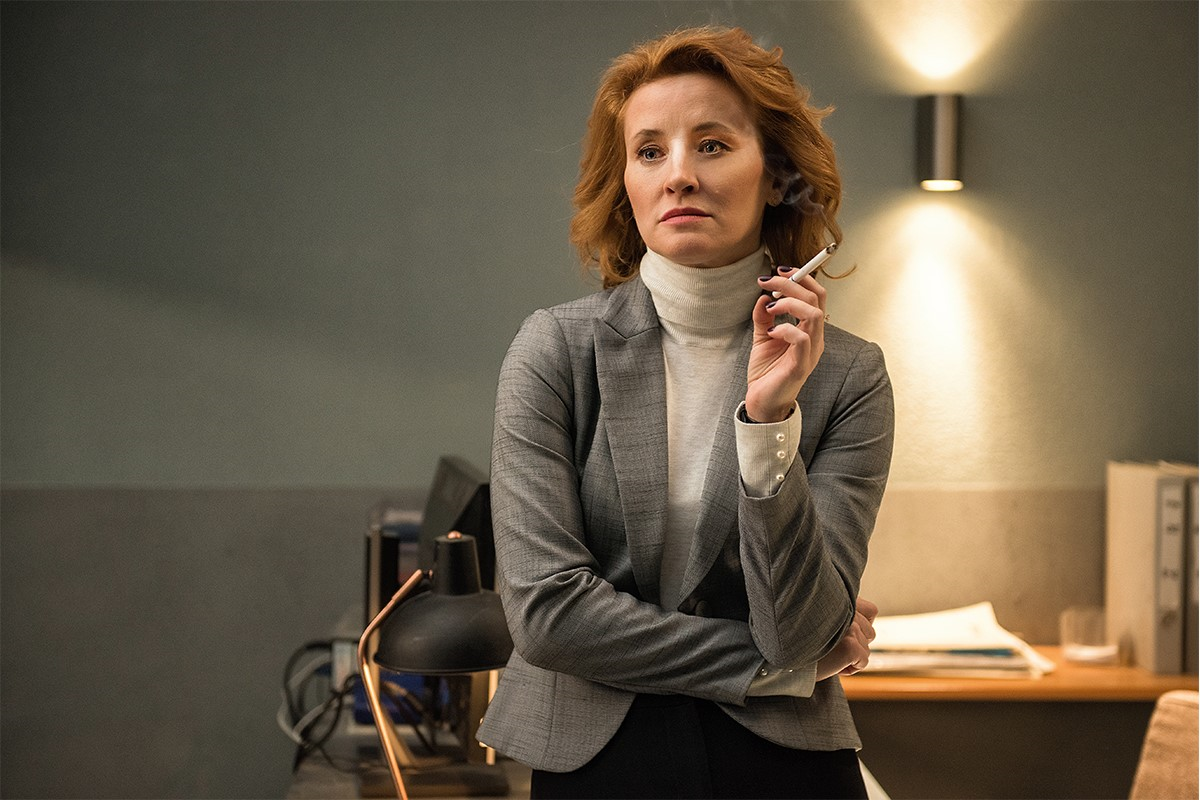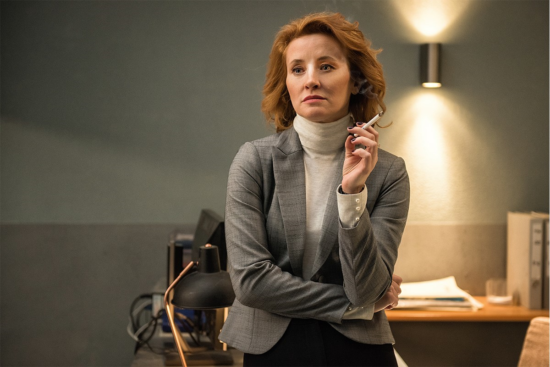
On a little island in the Canaries with very rocky terrain that in times past made communication very difficult in the absence of modern day technology, the locals invented a whistling language, a whistled version of Spanish, “El Silbo”, that is still being used today. That was the idea where Corneliu Porumboiu’s latest film originated. The island is called La Gomera. The film La Gomera (The Whistlers) is a neo-noir thriller with inflictions of black humour and it is indeed woven around El Silbo. In the true vein of classic noir, the film portrays a post-crisis period, with morally ambiguous characters, especially the main male character, Cristi, played by Vlad Ivanov, a corrupt cop – alienated from society, on the edge of moral conduct and law, flawed yet human, charting a course through a disillusioned life and towards a doomed fate he seems to have no control over. Cristi is schooled in this whistled language on the island in order to get a crooked businessman out of prison and this initiation becomes a crucial part in his journey.
The time of day is appropriately night, because the day always seems to vanish rapidly like the cigarettes the characters are incessantly smoking, the idyllic island gradually turns into a dark and chilly place, the meandering scenario only thickens as the plot advances, everybody is making you doubt them. It is a life and death world. But Corneliu Porumboiu’s world is a highly stylized world, skillfully constructed, blending reality and imagination, a clear and intentional departure from the realism of the Romanian New Wave and taking a new and fresh direction. It is also an homage brought to cinema in general and to classic cinema in particular, with Hitchcock, Jean-Pierre Melville and western film references throughout the entire story. Ultimately, it is a beautiful piece of cinema and a visually complex film where every camera movement, every frame, every use of colour, every piece of clothing, every dim light counts.
In my interview with costume designer Dana Păpăruz, we talk colour, costume and visual storytelling. Dana reveals the collaborative visual work for the film, how she used colour to establish the character of the femme fatale, the Greta Garbo influence and what part Picasso’s blue period played in the movie.
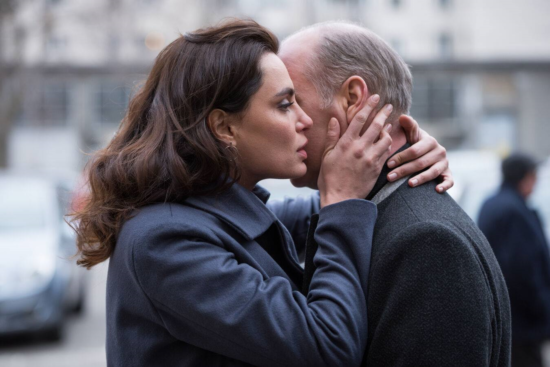
We first see Gilda, Catrinel Marlon’s character, in the present day, on the island of La Gomera, but we are properly introduced to her in a flashback, immediately following. In both sequences she is wearing a red dress. In the flashback, when she is in Bucharest, she is wearing a blue/grey trench coat first, blending in with the grey surroundings of the cold city, but then she takes it off and appears in the red dress (different than the one she wears on the island). Was the colour of the dress important to establish her as a femme fatale?
I will start by trying to explain what this project was based on, not just what I, as costume designer, wanted to achieve in this film. First, I would like to say that the entire film was well thought out and tightly controlled from a visual point of view. All the persons in charge of the different visual departments met, talked, made suggestions and eventually came to conclusions. And I am not only talking about Corneliu Porumboiu, the director, and about Mircea Tudor, the cinematographer, but also about the production designer, the costume designer, the light engineer, the make-up artist. Arantxa Etcheverria, the artistic director, was the one who came up with the idea of dividing the film in chapters, with each chapter revolving around one of the colours of the rainbow. So, apart from the fact that each chapter is introduced through one colour, that same colour is used in the respective chapter in different subtle ways to build up the plot, to attract the attention to certain things. La Gomera was one of the few projects in the present day (a complete surprise for me as well, this kind of approach for a Romanian film) where the crew had this desire to work together in order to create a unitary product, stylistically and chromatically.
We all met in the first part of pre-production, we made camera, lighting, filter tests and every other possible test that could influence the image of the film, all sorts of camera movements along with changes in lighting setting or the actors’ placement. We came with suggestions regarding materials, textures and colour combinations… in short, we thought just about every scenario that could occur during filming in different situations or locations, that is to say our future space for play and creation.
So the first chapter, named Gilda, is red, representing the first colour from ROYGBIV (or ROY G. BIV). And what colour would have been better for Gilda than red, a colour loved by a femme fatale, a character played so naturally by Catrinel, if I may say so? Of course, red is used in other ways, too, not just in Gilda’s dresses. The sofa in Cristi’s living room where Gilda takes a seat is also red, as a coincidence filled with humour, irony and as a confirmation of the fact that what is supposed to happen, will happen. Nothing looks pleonastic in the sequence where the two splashes of red meet, but rather slightly surreal, otherworldly, just like the feeling I had on the island. The grey of the city and its ugly parts were faded out by these chromatic ideas which were able to create a new reality where the spectator is transported to for one hour and a half. The time of day for filming was also important, that’s why a lot of the exteriors were filmed at night, so that the lights could play their own part.
I am glad you mentioned the grey city, because there is indeed something different that I noticed about the Bucharest depicted in this film. In many contemporary Romanian movies, Bucharest seems to be a character in itself, and it’s somehow become a repetitive image. What I loved about La Gomera, is that the world it depicts is a fabricated, highly-stylized world, a world that skillfully blends reality and imagination, leaving behind the realism of the Romanian New Wave and taking a new direction. What was the general feeling working on the project?
Trying to steer away from the harsh reality, the sadness, the depression, the ugliness that surrounds us in this grey city does not mean you can not create emotions; it’s just that these emotions are an intentional departure from this realistic new wave. Therefore, I had specific discussions with Corneliu Porumboiu on the subject, as he expressed this clear intention of trying to avoid the depiction of this crude reality by choosing to film at night most of the time and by making use of different types of lighting and thus creating a more plastic and optimistic setting and atmosphere of the movie.
So the general feeling was one of freshness and new, without challenging the principles of style too much just for the sake of showing off or of being different. Everything makes sense from the visual point of view and I believe this should be the guide line with every project. And I don’t think this costs more money, at least not as far as the costumes are concerned. Bad costumes can cost just as much as well made/chosen costumes.
So we have chapters and specific colours – I actually realised this halfway through the film when I watched it the first time and then paid proper attention when I watched it again. The colour is sometimes used to define the character through costume, like in the case of Gilda, or to advance the plot in some other way, like the yellow bag in the third chapter (the colour yellow also appears in the motel), or the violet tulips in the Magda chapter (Magda’s shirt is also violet). And, from what I understand, not everything was in the script, it was a work in progress.
The colour was definitely not meant just to shape the characters. Part of what we initially thought out didn’t make it in the editing room, but a big part of the concept is still in the film and it helps guide the viewer through the narrative… The yellow bag with money from Zolt, the Chinese woman’s yellow bag, the tulips and the shirt, Magda’s top at the end, but others, too, like the violet medical uniforms worn by the Spaniards in the hospital, as well as the shirts worn on La Gomera by Paco, Cristi or Kiko. Some of the chromatic elements I think of right now unfortunately don’t appear in the final cut, so their mentioning would only cause confusion. I somehow find it hard to straighten out the sequences at the moment, more than one year since the filming ended, because each detail was treated with the same importance, the ones that made the cut and the ones that didn’t. I think I should watch the film again at least once.
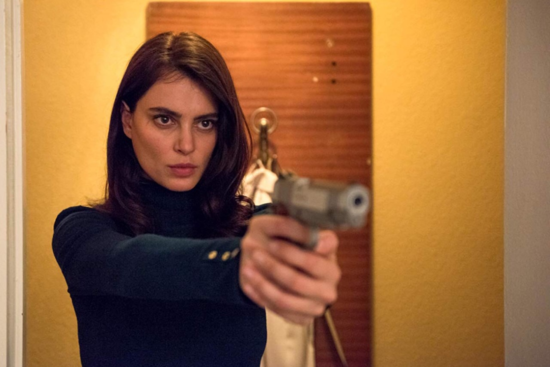
Did you come up with the idea of the yellow bag? I have to admit that sometimes I tend to read too much into details and costumes, which is maybe why it made me think of Hitchcock’s Marnie and Tippi Hedren’s yellow bag as she walks on the platform in the train station (the sequence in La Gomera also takes place at the station). Was this, by any chance, another cinematic reference from the part of Corneliu Porumboiu, as in the case of the motel?
The idea of the yellow bag belonged to the set designer, but I came up with the idea of the yellow bag and of the yellow details in the Chinese woman’s scarf. Anyway, I don’t think it would be fair to say a certain idea belonged to someone in particular, because it really was a collaborative effort to bring subtle contributions to each chapter and its chromatic.
And, yes, Hitchcock was one of Corneliu’s influences, not necessary a film in particular, but rather the atmosphere, a feeling, the suspense. There were nonetheless certain characters who were built with Hitchcock’s characters in mind. For example, Istvan Teglas’ character (the manager of the motel), who had as inspiration Anthony Perkins in Psycho; or the character who is monitoring the recording cameras in Cristi’s home – this is a Hitchcock reference too. Even from a stylistic point of view, Corneliu wanted the characters to transcend time, he wanted to go back to the classic style and streamlined aesthetic of the 1950s. Along with Hitchcock’s films, classic westerns were another reference; it is a western that is playing at the cinema where Cristi meets Magda, and the place where Zolt and the Spanish gang are caught and killed is also a western set.
The sequences with Istvan Teglas and with the policeman who is watching the recording cameras from Cristi’s home (and it’s incredible how those scenes, confined to that little space and with only this character in close-up keep your attention up) are so well thought out and I love it that there’s a trait of humour in them, just as it was in all Hitchcock’s films. But the film’s unified, visually distinctive look (a clear collaborative work of all the artistic directors, as you said) also reminded me of the films of Tarantino and Almodóvar. You also mention the westerns, and I wanted to bring this into discussion, too. Cristi invites Magda to the cinema to try to cut a deal with her and there is a John Wayne movie playing. And it’s not just any cinema, but Eforie, about the only remaining cinema in Bucharest that still projects classic films and world cinema movies. Did Corneliu want to tell us something by that? The film is like a love letter to cinema from the director.
That’s right, with the two western scenes inserted in our film (the western with John Wayne, but also the Sergiu Nicolaescu film they watch at the Ana Aslan sanatorium), Corneliu pays homage to both the classic western and the Romanian classic cinema. There is a trait of humour in that, too, and subtle irony. For the sake of these films and for all those who love film, I hope the closed cinema theaters will be reopened.
Corneliu Porumboiu is undoubtedly a director who pays great attention to every detail. Do you usually talk about the costumes with a director or is it more a conversation about characters and their evolution?
As I have tried to stress out, my collaboration with Corneliu was not merely a presentation of his ideas and my execution of those ideas, but a collaborative work in the true sense of the word, the way it should be on every film, no matter how small, or regardless of budget. Unfortunately, this doesn’t happen every time, it also depends on each director’s sensibility, on his/her visual training, but also on their willingness to devote time, attention and energy to every single detail that goes into the making of a film. For some directors, it’s only the relationship with the actors and their working on the script that matters, for others, as was in our happy case, everything mattered. After all, any screenplay is just a pretext for creating an imaginary world in the viewer’s mind. Everything that surrounds this text, this script, makes the film whole, because what looks good on paper doesn’t necessarily translate well on screen. Maybe I am too exigent, but that’s what I think. Working in cinema is hard enough and I wouldn’t want to belittle it by making do with creating a few costumes, doing a little shopping and a couple of fittings. Only when the spectator notices these elements which you have also observed and starts asking questions, only then the film becomes a creation. La Gomera was a great gift for me form this point of view and I would repeat the experience any time.
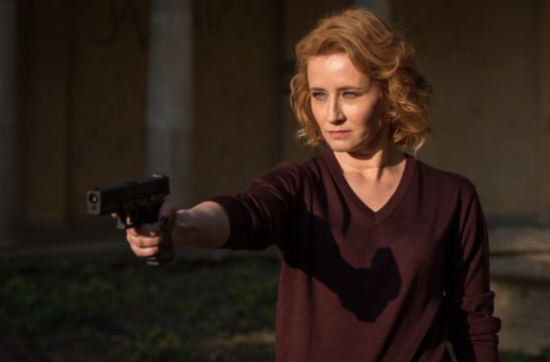
Magda (Rodica Lazăr) is a prosecutor. Her clothes are sharp, buttoned up, menswear inspired, she is always impeccably dressed, fit for the job. There seems to be no double-talk about her character. Is that what her clothes suggest?
Even Magda was inspired by an iconic figure of classic cinema. The character, but also Rodica Lazăr‘s presence, reminds of Greta Garbo, and by that I am referring to Garbo’s characters or the moments when she wore her well known avandgarde 1930s looks, menswear inspired, but very feminine nonetheless, and elegant, she seemed unattainable somehow, and that was due to both her acting and her costumes. So the wide-legged and high-waisted trousers, the short-waisted and body-hugging blazers and the buttoned-up shirts, the trench coats and classic coats fit Magda like a glove. Not only style-wise, but revealing a clear trait of the “incorruptible prosecutor” character who can not be fooled by appearances. Everything is straight about her look, serving its purpose, but never affecting her femininity.
Did you watch any Greta Garbo films to prepare for this character? Or any other films as research? I have read that Corneliu Porumboiu watched and re-watched many classic noir films when he was working on the script.
Yes, I had a long list of noir films I had to watch for research; I partially managed to watch them in the short period of time that I had, or at least parts of these films or archive footage. Regarding Magda’s look inspired by Greta Garbo, I think that was my idea, as a result of constantly looking for proper references for this character, the beautiful prosecutor. She too is a character enveloped in mystery, difficult to be placed in time.
We come to the third female character in Cristi’s life, his mother. Julieta Szönyi, who is known for the classic Romanian films Toate pânzele sus (All Sails Up) and Felix and Otilia, plays her. She is a woman of a certain social status and her clothes and poise show it. What exactly did you want to reveal about her past through her look?
The character Mama, played by Julieta Szönyi, for sure is a character with a past. She doesn’t give the impression of having been either poor in her youth, or without a well established status before the revolution, and she certainly was a very beautiful woman, she still is. She is elegant, she is wearing discrete but valuable jewellery, I would even say she looked a little eccentric in some sequences which unfortunately were left out, so I won’t get into these details. This is a character that required a lot of stylistic research through references and different fittings in order to be shaped the way she appears in the film.
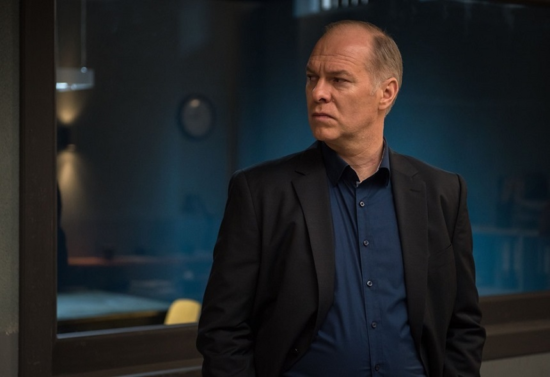
Let’s talk a little about Cristi. He dresses inconspicuously, in simple, classic clothes, but they are fine clothes nonetheless, they are not a faithful representation of real-life policemen (there is an obvious difference between his clothes and his colleague’s, Alin’s, clothes). Yes, he may be higher in rank and towards the end of his career, but his look also alludes to improper ways of earning more money. His expressions are very subtle, too, his movement is minimal, his character evokes feelings of both escape and imprisonment from/in certain rules, system, society. He doesn’t seem to belong to either world, he is very detached, he seems resigned, and I see his clothes as an important sign in regard to this character attribute. How would you describe him?
Cristi also draws from these classic characters. Two sources of inspiration for him were Yul Brynner and the characters from Le cercle rouge. The same stylistic simplification was applied to his character. I have to admit that at the beginning of the project I found it difficult to resist the temptation of being too showy or of revealing too much with some details or characters, but I came to realise that sometimes less is more. And it was a joint effort, a team work, always searching, negotiating even, and eventually reaching the best decisions. I am not saying I wouldn’t change anything right now, I am saying that at that moment, in the little time we had, each one of us gave their best.
Yes, Cristi is clearly a different personality than Alin, a different age, a different generation, mentally and as to how liable he is of being corrupted, but he is also after all a man pushed to his limits. I think your description is very correct and that is also what we wanted to transmit through his costumes. But Vlad Ivanov was also asked to lose some weight for the role, so I tried to elongate his silhouette by using ton-sur-ton looks. Throughout the film, Cristi always wears navy shades, with very little exceptions, like his clothes on the island, where the overall look of some frames was asking for something different. You don’t really know what to make of this character, it is as if time has stood still for him, he is consciously detached from his clothes, as opposed to other characters.
Zolt, on the other hand, looks like a guy who pays attention to his clothes. That is the impression I got from his character. He wears muted, natural colours, too, but the image he projects is different (I recall the cardigan with a rich fabric), and he seems to have worked hard at his overall look in order to project a certain image. Am I wrong?
Zolt was another character that required much research, especially that his scenes didn’t require a large variety of clothes. He practically comes disguised when he first meets Cristi, then the next outfit (including the cardigan you mention) is the one he is wearing when he is caught and then taken to interrogation, then the clothes he wears when he is taken out of the hospital could have very well been given to him by those who kidnap him.
I have to admit I was very happy with the choice we made for Zolt’s arrest sequence, because, if you are paying close attention (and for those who have the knowledge), those frames, chromatically speaking, seem depicted from Picasso’s blue period paintings. All this preparation and work we did were also supported by the post-production colouring. We tried to solve most of the chromatic part during filming, everything was thought out as a whole, everything had to be in relation with the surroundings (characters, decor, plus lighting, filters, etc.), then the wonderful team in charge of colouring made the necessary improvements.
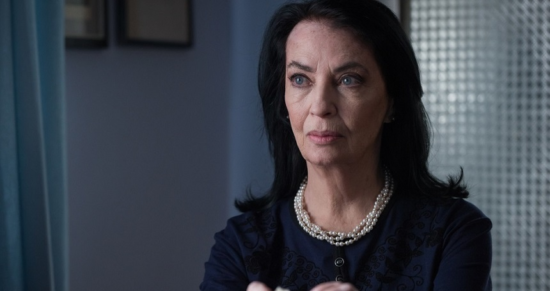
A costume designer’s job is to reinforce the story and help the actor form an identity of his/her character. But what exactly goes into the work of a costume designer today? How much ready-made shopping, how much vintage and how much making did the costumes in La Gomera involve? Did you also talk to the actors about their clothes?
I have talked in detail about their characters with some actors, with others unfortunately hardly at all, but that doesn’t mean the supporting characters were not invested in properly. I don’t think there is a rule, each project is different when it comes to making or finding the costumes. Yes, it is a combination of making, shopping, thousands of alterings and sourcing vintage objects. For Gilda, for example, half of her wardrobe was specifically created for the film, there were also a few other outfits that didn’t make it to the final cut, but which were necessary so that we had a larger variety we could choose from on the day of filming, to have freedom of choice. Practically, there is always a stock of costume, even if each costume is usually decided in advance when discussing each sequence. We are always on the lookout, always prepared to face unpredictable situations. And that is because sometimes changes occur to the script to the very last minute, or because of the weather, or even as a result of the on-going discussions we are having during filming.
Which were the costumes you specifically made for Gilda?
Most of the dresses were made: the two red dresses from the first chapter, but also the grey-blue coat, the green skirt and the yellow shirt dress she wears on the island in the sequence after the beach (the one with the red car), her navy dress from the end of the film, in Singapore – we also had an ivory version for this one, but decided not to use it because of the weather (it was raining, so the dress would have been too revealing). And there were a couple of other dresses which didn’t find their place eventually, but I don’t regret it, I think we made the right choice for every Gilda moment.
Often contemporary costume design does not get the attention it deserves and it is the historical, period or fantasy films that are considered more fascinating in a visual way and more challenging for a costume designer. You have done both. How do you feel about that?
If I were to choose what challenges me more, I wouldn’t know what to answer. If I were to say what I prefer, I would say period costume. But indeed I have done and will always do both. Because in this way you can be challenged in different ways and if I succeed to get the public’s attention with a contemporary project, then I find that even more valuable. In other words, both La Gomera and the HBO tv series Umbre (Shadows) have a special place in my heart.
Photos: film stills „La Gomera” | 42 km Film
This piece is published courtesy of classiq.me
